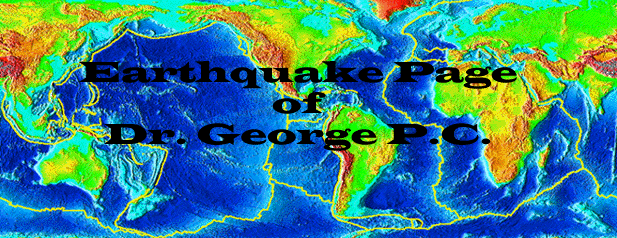The
Earthquake of September 7, 1999 in Athens, Greece
George
Pararas-Carayannis

Introduction
  On Tuesday, 7 September
1999, a powerful earthquake struck nea Athens, Greece. This
was the strongest earthquake to hit Athens in nearly a century
and the worst to hit Greece in nearly 20 years. The quake killed
dozens of people. Dozens more were trapped beneath the rubble
of collapsed buildings. Hundreds more were injured and thousands
more were left homeless. Preliminary assessment shows that 672
homes were destroyed beyond repair while 2,217 more were in need
of repair. The greatest damage to buildings, occurred in the
Athens suburbs of Menidi, Ano Liosia, Nea Filadelphia, Nea Ionia,
Kifissia and Zefyri. There was no apparent damage to the Acropolis,
to the Temple of Zeus, and other antiquities in the area. On Tuesday, 7 September
1999, a powerful earthquake struck nea Athens, Greece. This
was the strongest earthquake to hit Athens in nearly a century
and the worst to hit Greece in nearly 20 years. The quake killed
dozens of people. Dozens more were trapped beneath the rubble
of collapsed buildings. Hundreds more were injured and thousands
more were left homeless. Preliminary assessment shows that 672
homes were destroyed beyond repair while 2,217 more were in need
of repair. The greatest damage to buildings, occurred in the
Athens suburbs of Menidi, Ano Liosia, Nea Filadelphia, Nea Ionia,
Kifissia and Zefyri. There was no apparent damage to the Acropolis,
to the Temple of Zeus, and other antiquities in the area.

Earthquake
Epicenter, Origin Time, Magnitude and Aftershocks
 The earthquake's epicenter
(38.13N 23.55E) was approximately 20 kilometers northwest of
Athens, between Menidi and Mount Parnes, which is a national
park and sparsely inhabited. According to the Athens Seismological
Institute, the earthquake's magnitude was 5.9 on the Richter
scale and it occurred at 23:07:41. It was felt across the Aegean
Sea and as far away as the city of Izmir, Turkey, about 180 miles
east of Athens. The earthquake's epicenter
(38.13N 23.55E) was approximately 20 kilometers northwest of
Athens, between Menidi and Mount Parnes, which is a national
park and sparsely inhabited. According to the Athens Seismological
Institute, the earthquake's magnitude was 5.9 on the Richter
scale and it occurred at 23:07:41. It was felt across the Aegean
Sea and as far away as the city of Izmir, Turkey, about 180 miles
east of Athens.
In Athens
and surrounding suburbs, the quake was felt with great intensity.
This is attributed to the orientation of the fault that produced
it, with the city; also because the depth of the quake's focus
was relatively shallow (10 km). In the few days following the
main earthquake more than 700 aftershocks were recorded, including
eight with magnitude over 4, and one that registered 4.7.

Tectonic
Setting - Geological Instability of the Eastern Mediterranean
Basin

Modified After
Nafi Toksoz of MIT/ERL
The eastern
Mediterranean basin where the Anatolian plate extends, is one
of the world's most intense seismic zones where large destructive
earthquakes occur with frequency. The geological instability
and the resulting earthquakes are caused by the active grinding
of the Anatolian plate wedged against the continental plates
of Africa, Eurasia and Arabia. As these larger tectonic plates
grind against the Anatolian plate, Asia Minor and Greece move,
smashing closer together in some places and drawing apart in
other regions. The 500-mile North Anatolian fault marks the northern
boundary of the Anatolian plate grinding against the Eurasian
plate. This great fault zone appears to be moving eastward at
the present time. At its western end it impacts on the North
Aegean fault, a volcano-dotted undersea rift that runs down the
middle of the Aegean Sea. The fault zone then meanders under
Greece and heads up the Ionian and Adriatic Seas. As a result
of active interaction and movement along these major faults,
hundreds of earthquakes of all sizes are recorded every year
throughout this region. Since 1964, more than 20,000 quakes have
been recorded around Greece alone
(see
U.S.G.S map below (modified)).

 The Seismicity
of Central Greece The Seismicity
of Central Greece
The long-term
seismicity of central Greece is clearly different from that of
neighboring Anatolia to the east, in that no earthquakes of magnitude
greater than 7.0 occur - or at least nothing that large is known
to have occurred in the last 500 years. In contrast, earthquakes
with magnitude greater than 7 have occurred with greater frequency
in Anatolia and in other parts of the Middle East in the last
100 years.
In recent times, in 1968, a magnitude 7.1 quake on the North
Aegean fault near the island of Aghios Efstratios, killed 20
people. Up to now, the deadliest earthquake in Greece occurred
in 1978 in the northern port of Thessaloniki. It had a magnitude
of 6.5 and resulted in 45 deaths.
( Seismicity
of Greece - Epicenter of the September 7, 1999 earthquake- Modified
USGS map)

Was
the earthquake of September 7, 1999 in Greece a consequence of
the August 17 earthquake in Turkey? Is there a relationship with
the Turkish earthquake ?
It appears
that following the Turkish earthquake that struck north-western
Turkey on August 17, 1999, there has been an increase in seismic
activity in the entire eastern Mediterranean Sea and particularly
in the Northern Aegean Sea where the North Anatolian Fault meets
the Northern Aegean fault. Therefore, the Turkish earthquake
appears to have an effect over a wider area than it would be
ordinarily expected. After the quake in Turkey, it is very possible
that the North Anatolian fault activated other faults in the
Greek region. The two recent earthquakes in the sea region between
the islands of Imvros and Samothraki,in the Northern Aegean Sea,
are suggestive of such direct influence. However the earthquake
in Central Greece occurred on a different and distant fault.
Therefore there is no clear or apparent direct connection with
the Turkish quake. The closeness in their timing may be just
a statistical coincidence.
Nonetheless,
it should be emphasized that the dynamics of the tectonics of
the Anatolian plate are not well known or understood. Strong
earthquakes, as the one that occurred in Turkey, appear to have
a tendency to migrate and to stimulate a wider zone, resulting
in subsequent crustal compensation along other areas of accumulated
seismic strain. Therefore, an increased amount of seismic activity
in one area of the Anatolian plate could be expected to affect
other areas of the same plate. In the short term, the potential
risk from earthquakes in this region must not be discounted.
In the short term, additional seismic activity can be expected
in the eastern Mediterranean basin .

Has
the seismic strain been released by the September 7, 1999 Earthquake
in the Athens Region? Is there danger of another large earthquake
in the area in the near future?
Following
the Athens earthquake of September 7, 1999, the strength of the
aftershocks has been steadily decreasing. This reduction in the
magnitude of the aftershocks indicates that most of the seismic
strain along the fault, which gave rise to the main quake, has
been released. There is no apparent danger of another destructive
earthquake in the near future. However, smaller aftershocks should
be expected to continue for some time.

Past
earthquakes which have affected the City of Athens
 Although numerous earthquakes
have occurred in central Greece throughout history, most have
been of medium size, relatively shallow in depth, destructive
only in the immediate vicinity, and have resulted in relatively
small losses of life. Historically, the city of Athens has not
been struck very frequently or has been extensively damaged by
past earthquakes. The September 7, 1999, earthquake was an exception
in that the epicenter was much closer to the city than previous
events. Although numerous earthquakes
have occurred in central Greece throughout history, most have
been of medium size, relatively shallow in depth, destructive
only in the immediate vicinity, and have resulted in relatively
small losses of life. Historically, the city of Athens has not
been struck very frequently or has been extensively damaged by
past earthquakes. The September 7, 1999, earthquake was an exception
in that the epicenter was much closer to the city than previous
events.
According
to Nicholas Ambraseys of the Imperial College of London, earthquake
damage in the city of Athens during its long history has been
very infrequent, small, and primarily caused from relatively
large earthquakes with epicenters considerably distant from the
city. According to Ambrassey's historical earthquake catalog,
the strongest earthquake in the Athens area this century, occurred
on October 17, 1914. It occurred between Thiva and Chalkis and
had a magnitude 6.2. on the Richter scale and an epicenter approximately
47 Kilometers from Athens. This earthquake destroyed a small
number of older houses, but caused relatively minor damage to
a few buildings.
(Modified
figure from Ambraseys showing the epicenters of important historical
earthquakes (Ms 6.0 +) in Greece for the period between the 5th
century BC and the 19th century. - Solid circles are for events after 1890, and
their epicentral regions are shaded. - Solid squares are approximate
epicentres of events of the 19th century. - Open squares are
locations of events before 1800. - Pre-1890 events are labeled
with the year of their occurrence: those that may have been smaller
than Ms 6.0 are labeled with a bar. Dashed lines show major tectonic
structures.)
Also, the
historical record shows that, in addition to the 1914 event,
damage was caused by earthquakes in the Athens area in 1705,
1894, 1928, 1930, 1981 and, more recently, in 1995. These quakes
had epicenters which varied in distance from 40 to approximately
180 km from the city of Athens.
The April
22, 1928, earthquake had a magnitude 6.3. Its epicenter was near
Corinth approximately 77 km, from Athens. It resulted in some
minor damage to a small number of older houses.
The April
17,1930 earthquake was a 5.9 magnitude event which occurred on
the SW coast of Gulf of Saronicos, approximately 59 km from Athens.
Only 4 old houses collapsed in the city and few more had cracks.
The July
20, 1938 earthquake in Oropos, about 37 km north of Athens, had
a magnitude 6.1. It was strongly felt in the city where it caused
minor damage.
The July
6, 1965 earthquake had a magnitude 6.4 with its epicenter offshore
in the Gulf of Corinth, about 122 km from Athens. It was generally
felt in the city but it caused no damage.
Of all recent
earthquakes, the quake of February 24, 1981, with magnitude 6.7
and its epicenter in the Alkionides near the port of Corinth,
approximately 77 km southwest of Athens, was the most destructive
in terms of loss of life and damage to property. It killed 20
people. Strong aftershocks followed, one of them five hours later
with a magnitude 6.4 and epicentral distance of 60 km from Athens.
The main shock and the aftershocks damaged about 500 houses and
caused widespread but minor damage to a number of public buildings,
including museums exhibiting archaeological antiquities.
Lastly,
a 6.1 magnitude earthquake occurred in 1995 in Aegio, approximately
120 miles southwest of Athens. It was responsible for 26 deaths
in the region.

 Did the Earthquake of September
7, 1999 generate a tsunami? Did the Earthquake of September
7, 1999 generate a tsunami?
No, it did
not. Earthquakes in Central Greece, with the exception of those
occurring near the Corinthian Gulf, are not known to produce
tsunamis. However, this is not always the case elsewhere in Greece.
The historical record shows that
numerous large destructive
earthquakes and tsunamis
have
occurred from antiquity to the present in the Eastern Mediterranean
Sea and particularly in the Aegean Archipelago.
(Sparta
earthquake of 413 B.C.)

References
Ambraseys N. , Earthquakes in Athens, Imperial College, London
Ambraseys, N. and Jackson, J., 1990. Seismicity and associated strain of central
Greece between 1890 and 1988.
Geophys. Journ. Intern., 101: 663-708.
Angelier J., Lyberis N., Le Pichon
X., Barrier E. and Huchon P. (1982). The tectonic development of the Hellenic
arc and the Sea of Crete : a synthesis.
Tectonophysics, 86, 159-196.
Angelier J. (1979). Recent quaternary tectonics
in the Hellenic Arc: examples of geological observations on land. Tectonophysics, 52, 267-275.
Galanopoulos, A., 1953. Katalog
der Erdbeben in Griechenland fur die Zeit von 1879 bis 1892. Ann. Geol. Pays Helleniques, 5, Athens.
Galanopoulos, A., 1956. I
seismiki epikindynotis ton Athinon.
Praktika Akadem. Athenon, Athens.

Links
to other Web Sites for More Information on the September 7, 1999
Earthquake and the Potential for Destructive Tsunamis in Greece
National Observatory of Athens (NOA)
National Observatory of Athens, Institute
of Geodynamics
European-Mediterranean Seismological
Centre
Seismo-Surfing the Internet (Steve
Mallone) ETH, Zurich
Tsunami
Potential in Greece.html
 RETURN TO
RETURN TO

Links
to other Pages
 NEW BOOK - THE
BIG ONE- The Next Great California Earthquake
NEW BOOK - THE
BIG ONE- The Next Great California Earthquake
 now available from
Amazon, Barnes and Noble and other major bookstores. It can be
also ordered by contacting directly Aston
Forbes Press.
now available from
Amazon, Barnes and Noble and other major bookstores. It can be
also ordered by contacting directly Aston
Forbes Press.

OTHER MISCELLANEOUS NON-TECHNICAL WRITINGS



|